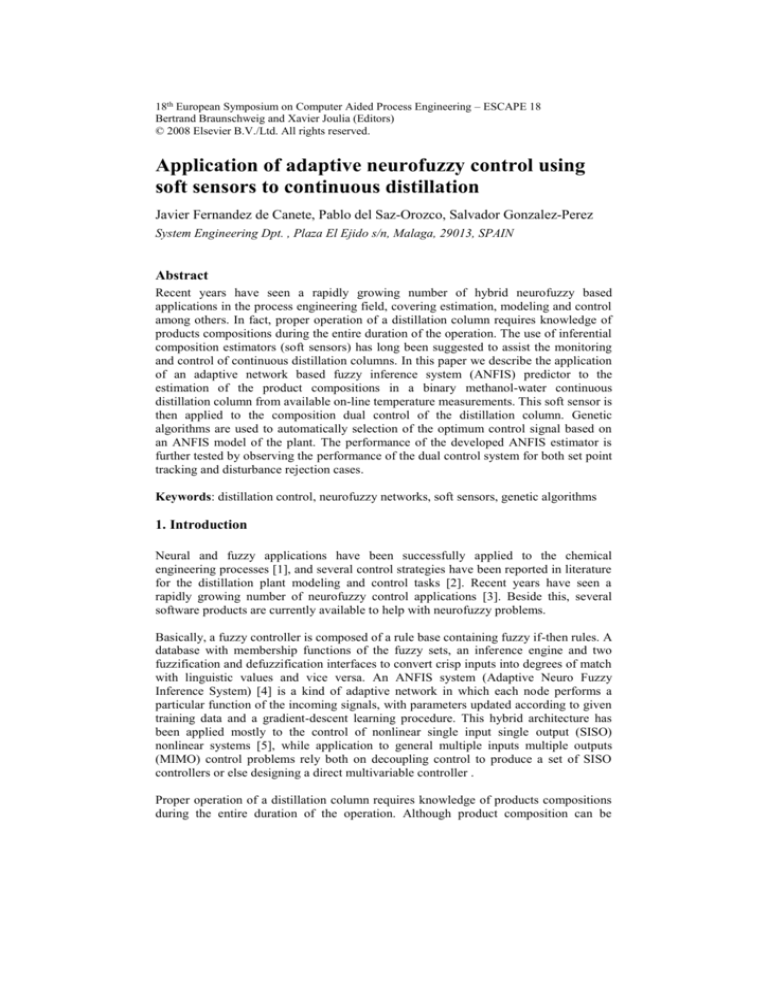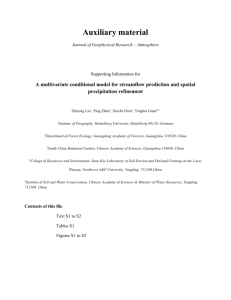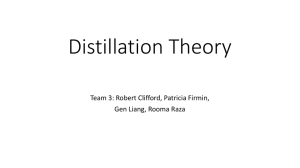
18th European Symposium on Computer Aided Process Engineering – ESCAPE 18
Bertrand Braunschweig and Xavier Joulia (Editors)
© 2008 Elsevier B.V./Ltd. All rights reserved.
Application of adaptive neurofuzzy control using
soft sensors to continuous distillation
Javier Fernandez de Canete, Pablo del Saz-Orozco, Salvador Gonzalez-Perez
System Engineering Dpt. , Plaza El Ejido s/n, Malaga, 29013, SPAIN
Abstract
Recent years have seen a rapidly growing number of hybrid neurofuzzy based
applications in the process engineering field, covering estimation, modeling and control
among others. In fact, proper operation of a distillation column requires knowledge of
products compositions during the entire duration of the operation. The use of inferential
composition estimators (soft sensors) has long been suggested to assist the monitoring
and control of continuous distillation columns. In this paper we describe the application
of an adaptive network based fuzzy inference system (ANFIS) predictor to the
estimation of the product compositions in a binary methanol-water continuous
distillation column from available on-line temperature measurements. This soft sensor is
then applied to the composition dual control of the distillation column. Genetic
algorithms are used to automatically selection of the optimum control signal based on
an ANFIS model of the plant. The performance of the developed ANFIS estimator is
further tested by observing the performance of the dual control system for both set point
tracking and disturbance rejection cases.
Keywords: distillation control, neurofuzzy networks, soft sensors, genetic algorithms
1. Introduction
Neural and fuzzy applications have been successfully applied to the chemical
engineering processes [1], and several control strategies have been reported in literature
for the distillation plant modeling and control tasks [2]. Recent years have seen a
rapidly growing number of neurofuzzy control applications [3]. Beside this, several
software products are currently available to help with neurofuzzy problems.
Basically, a fuzzy controller is composed of a rule base containing fuzzy if-then rules. A
database with membership functions of the fuzzy sets, an inference engine and two
fuzzification and defuzzification interfaces to convert crisp inputs into degrees of match
with linguistic values and vice versa. An ANFIS system (Adaptive Neuro Fuzzy
Inference System) [4] is a kind of adaptive network in which each node performs a
particular function of the incoming signals, with parameters updated according to given
training data and a gradient-descent learning procedure. This hybrid architecture has
been applied mostly to the control of nonlinear single input single output (SISO)
nonlinear systems [5], while application to general multiple inputs multiple outputs
(MIMO) control problems rely both on decoupling control to produce a set of SISO
controllers or else designing a direct multivariable controller .
Proper operation of a distillation column requires knowledge of products compositions
during the entire duration of the operation. Although product composition can be
2
"J. Fernandez de Canete et al."
measured on-line, it is well known that on-line analyzers are complex pieces of
equipment that are expensive and difficult to maintain. They also entail significant
measurement delays, which can be detrimental from the control point of view [6].
Therefore, to circumvent these disadvantages, it is possible to estimate the product
composition on-line, rather than measuring it. The use of such inferential composition
estimators (or soft sensors) has long been suggested to assist the monitoring and control
of continuous distillation columns [7].
Genetic algorithms (GA) are model machine learning methodologies, which derive their
behaviour from a metaphor of the processes of evolution in nature and are able to
overcome complex non-linear optimization tasks like non-convex problems, noncontinuous objective functions, etc. [8]. They are based on an initial random population
of solutions and an iterative procedure, which improves the characteristics of the
population and produces solutions that are closer to the global optimum. This is
achieved by applying a number of genetic operators to the population, in order to
produce the next generation of solutions. GAs have been used successfully in
combinations with neural and fuzzy systems. Particularly in neurofuzzy control, GAs
have been utilized extensively to tune the neurofuzzy controller parameters and acquire
the fuzzy rules [9].
In this paper we describe the application of an adaptive network based fuzzy inference
system (ANFIS) predictor to the estimation of the product compositions in a binary
methanol-water continuous distillation column from available on-line temperature
measurements. This soft sensor is then applied to train an ANFIS model so that a GA
performs the searching for the optimal dual control law applied to the distillation
column. The performance of the developed ANFIS estimator is further tested by
observing the performance of the ANFIS based control system for both set point
tracking and disturbance rejection cases.
2. Process Description
The distillation column used in this study is designed to separate a binary mixture of
methanol and water, which enters as a feed stream with flow rate Fvol and composition
XF between the rectifying and the stripping section, obtaining both a distillate product
stream Dvol with composition XD and a bottom product stream Bvol with composition XB.
The column consists of 40 bubble cap trays. The overhead vapor is totally condensed in
a water cooled condenser (tray 41) which is open at atmospheric pressure. The process
inputs that are available for control purposes are the heat input to the boiler Q and the
reflux flow rate Lvol. Liquid heights in the column bottom and the receiver drum (tray 1)
dynamics are not considered for control since flow dynamics are significantly faster
than composition dynamics and pressure control is not necessary since the condenser is
opened to atmospheric pressure.
The model of the distillation column used throughout the paper is developed by [10],
composed by the mass, component mass and enthalpy balance equations used as basis
to implement a SIMULINK model (figure 1) which describes the nonlinear column
dynamics as a 2 inputs (Q , Lvol ) and 2 output (XD , XB ). Implementations details for the
overall column dynamics are given in [11].
Application of adaptive neurofuzzy control using software sensors to continuous
distillation
3
Figure 1. Schematic of the SIMULINK model of the distillation
3. ANFIS Estimator
An ANFIS system is a kind of adaptive network in which each node performs a
particular function of the incoming signals, with parameters updated according to given
training data and a gradient-descent learning procedure. This hybrid architecture has
been applied to the modeling and control of multiple-input single-output (MISO)
systems [4].
f1
f2
Figure 2. Architecture of the ANFIS structure
The architecture of the ANFIS is constituted by several layers (fig. 2). If we consider for
simplicity two inputs x and y and two outputs f1 and f2 for a first-order Sugeno fuzzy
model, with Ai and Bj being the linguistic label associated with x and y respectively,
every node in layer 1 represents a bell-shaped membership function Ai (x) or B ( y )
i
with variable membership parameters. Usually we choose the bell-shaped functions.
Nodes of layer 2 output the firing strength defined as the product ji A ( x ) B ( y ) ,
i
i
where the set of nodes in this layer are grouped for each output j. A normalization
process is computed in layer 3 giving the normalized ji , and the Sugeno-type
consequent of each rule with variable parameters pi, qi and ri is implemented in layer 4
yielding fj as the output of the single summation node f i
ji( pi x qi y ri ) and
finally the single node of layer 5 computes de overall outputi as a summation of all
incoming signals.
4
"J. Fernandez de Canete et al."
The learning procedure consists of two stages. In the forward pass training input data go
forward the ANFIS architecture, and in the backward pass the error rates propagate
backward, being the both the consequent and the membership parameters updated by
gradient descent.
4. ANFIS-GA Controller
The complete ANFIS based estimation and control system is described below (figure 3).
yˆ[ k ]
T [k ]
ANFIS
ESTIMATOR
~
y [k ]
TDL
ANFIS
MODEL
+
-
u[k ]
e[k ]
GA
CONTROLLER
yd [k 1]
DISTILLATION
COLUMN
TDL : Tapped Delay Line
Figure 3.Estimation and Control ANFIS based structure
4.1. ANFIS estimator of the composition (ANFIS ESTIMATOR block)
In order to infer the composition from temperature an ANFIS net is used. Previously, a
sensitivity study is performed in order to choose the correct set of temperatures to infer
top and bottom compositions (figure 4). The sensitivity index proposed is defined as the
partial derivative of each available primary variable (product composition) with respect
to changes in each secondary variable (tray temperature).
dependency
41
36
31
tray
26
21
16
11
6
1
0
0,01
0,02
0,03
0,04
0,05
0,06
normalized derivate
Figure 4.Composition-temperature dependencies.
A three temperature vector T[k] [T41[k],T21[k],T1[k]] is selected as input to the ANFIS
predictor which output
the predicted values of composition vector
Application of adaptive neurofuzzy control using software sensors to continuous
distillation
5
yˆ[k ] [ Xˆ D [k ], Xˆ B [k ]] . After a trial-error process we have selected 5 membership
functions per input as a compromise solution between computation time and precision.
Normally, in a plant operation, both real values are measured off-line in the laboratory.
In this study, the ANFIS parameter update is made accepting the simulation results as
same with the actual plant data. Training set is generated by selecting 1200 temperature
data points obtained by during column open loop operation with range for LVol (0-5E-06
m3/h) and heat flow Q (0-2000 J/s) for fixed feed rate conditions FVol = 1 E-06 m3/h, XF =
0.3. An additional temperature data set consisting of 150 data points was used to test the
ANFIS predictor afterwards. The error in the training phase is under 0.00025% and
0.0015% in the validation phase. For training pattern generation we assume an initial
steady state for the column after a start-up process.
4.2. ANFIS modeling of the distillation column (ANFIS MODEL block)
Prior to the design of the controller, an ANFIS network has been used as an
identification model of the distillation column dynamics. To obtain representative
training data, varying feed flows, initial liquid composition values both in the column,
boiler and condenser along with input values for the control actions were imposed on
the model. The identification model has been carried out using an ANFIS network given
by ~y [k ] f ( yˆ[k ], yˆ[k 1], yˆ[k 2], u[k ]) after selecting the best structure among
possible ones, with u[k] [LVol[k],Q[k]] and yˆ[ k ] regularly spaced covering the same
range as defined in section 4.2. As the model’s dynamic will be modified with unknown
perturbations, this ANFIS model will be updated with the real plant response.
4.3. Genetic Algorithm Controller (GA CONTROLLER block )
As the estimation of the composition vector ~
y [k ] in the next simulation step according
the present and previous states of yˆ[k ] and the input to the system u[k] can be achieved
using the ANFIS model net, the control problem can be implemented as an optimization
problem in which the function to minimize is the difference between the desired output
yd [k ] and the estimated one ~y[k ] in the next step. As a result, the optimum control law
u[k] is elicited for the distillation control problem. This control approach enables the
searching of an optimum control signal for each point in the operating range of the
nonlinear distillation plant.
In order to search for the optimum for the highly non-linear function a genetic algorithm
is used with 75 members fixed population, 75 generations and random mutation. If an
error under 0.01% is achieved, the algorithm is stopped in order to accelerate the
simulations.
5. Results
The aim in the design of the composition ANFIS estimator is to use together with
ANFIS-GA for dual composition control of the distillation column. Therefore, the
composition estimator is tested by using the SIMULINK model before it is used for
control. The performance of the control structure is checked for set-point and
disturbance rejections, as is shown in figure 5.
6
"J. Fernandez de Canete et al."
Figure 5. Performance of the ANFIS-GA for a pulse change in top (bottom) product purity from
96% to 98% (4% to 2%) in t = 2000 s and change in XF from 40% to 30% in t = 4450 s.
6. Conclusions and Future Works
We have proposed a hybrid neurofuzzy design methodology to dual composition control
in a MIMO binary distillation column. An ANFIS structure has been employed both for
prediction of composition profiles from temperatures and design of optimum control
law using a GA search technique, by using an ANFIS model based fitness function. The
results obtained point to the potential use of this control strategy in areas of design
related to operability and control in process engineering. Future works are directed
towards the application of the proposed methodology to a real small scale pilot plant.
References
[1] A. Bulsari. Neural networks for chemical engineers. Elsevier, Amsterdam, 1995.
[2] M.A. Hussain, M. A. “Review of the applications of neural networks in chemical process
control. Simulation and on-line implementations”, Artificial Int. in Eng, Vol. 13 (1999) pp. 55-68.
[3] J. Engin, J. Kuvulmaz and E. Omurlu. “Fuzzy control of an ANFIS model representing a
nonlinear liquid level system”. Neural Computing and Appl., Vol. 13, n. 3 (2004) pp. 202-210.
[4] R. Jang and C. Sun. Neuro-fuzzy modeling and control. Proceedings of the IEEE 1995, Vol.
83 n. 3 (1995) pp. 378-405.
[5] M. Denai, F. Palis and A. Zeghbib. “ANFIS based modeling and control of nonlinear systems:
A tutorial”, Proceedings of the IEEE Conference on SMC (2004), pp. 3433-3438.
[6] H. Leegwater. Industrial experience with double quality control. In W. L. Luyben (Ed.),
Practical distillation control. New York, USA: Van Nostrand Reinhold, 1992.
[7] S. Park and C. Han. “ A non-linear soft sensor based on multivariate smoothing procedure for
quality estimation in distillation columns”, Comp. and Chem. Eng. Vol. 24 (2000), pp. 871-877.
[8] Z. Michalewitz, Genetic Algorithms + Data Structures = Evolution Programs, Springer,
Berlin, Germany, 1992.
[9] P. Fleming and R. Purshouse – Evolutionary algorithms in control systems engineering: a
survey. Control Engineering Practice, Vol. 10 (2002) pp. 1223–1241.
[10] M. Diehl, I. Uslun and R. Findeisen.”Real-time optimization for large scale processes:
Nonlinear predictive control of a high purity distillation column”, On Line Optimization of Large
Scale System: State of the Art, Springer-Verlag, 2001.
[11] J. Fernandez de Canete, S. Gonzalez-Perez and P. del Saz Orozco. “A development of tools
for monitoring and control of multivariable neurocontrolled systems with application to
distillation columns”, Proc. EANN 2007 Int. Conf., Thesaloniki, Greece, (2007), pp. 296-305.









